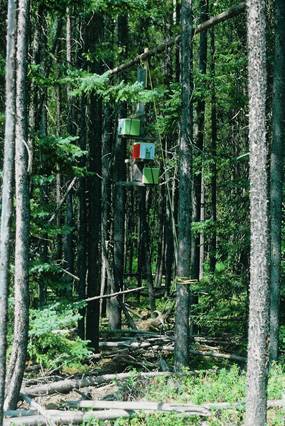Honey bees in bear territory.
Tibor I. Szabo and Daniel C. Szabo
RR1, Puslinch, Ontario, Canada, N0B 2J0
Draft
April 2005
In the spring of 2004 a black bear wandered from Northern Ontario South to Puslinch county. He destroyed 8 honey bee colonies approximately 3 km from our apiary. Shortly thereafter, we found one of our hives torn apart. The bear continued to wander South and was shot. The appearance of a bear in this part of the Province is very rare. In Southern Ontario, apiaries are not protected from bears. However, in a large part of Canada, protecting bees from depredation by bears is an essential and standard practice.
In the early spring of 1974, in the Peace River Area of North-Western Alberta, packaged bees were imported from California. The packages were installed into hives in a clearing of a woodlot. It was decided to build an electric fence around the bee yard in order to keep bears out. The fence was only half completed when, upon arriving at the bee yard, the first author discovered a bear standing on his hind legs beside a hive and opening it like a seasoned beekeeper. At the sound of the car’s horn, the bear ceased his destruction, looked at the vehicle and slowly ambled away from the hive into the forest.
Upon notification, officers from the Alberta Wildlife Service set up a leg-hold trap at this yard and a portable bear trap in a neighboring bee yard (Figure 1). The leg-hold trap was carefully set under poplar trees where the bear had previously hidden a few honey combs by partially covering them with dry leaves (Figure 2). A small fence was constructed to lead the bear into the trap (Figure 3). Pieces of beaver meat were scattered and beaver fat was melted and dripped along a trail to lead the bear to the trap. By the next morning the bear had been caught in the trap (Figure 4). Officers from the Wildlife Service tranquilized the bear and carried him, unconscious, into a clearing (Figure 5). The animal was measured for statistical purposes (Figure 6) and received an ear tag (Figure 7). The bear was then transported and released approximately 100 km away in a forested area.
After this incident each of our bee yards was equipped with an electric fence. Permanent apiaries were fenced with tamarack posts and five strands of barbed wire. The 1st, 3rd and 5th strands of wire were electrified and the 2nd and 4th were grounded. The fencer provided 10,000 V of pulsating electricity. In the case of a relatively short fence (< 50 m) a person operating the insulated tester could get a shock. Vegetation under the fences was regularly cut or sprayed with herbicide and the batteries were replaced with fully recharged ones every two weeks. In these yards there were no further problems with bears.
Isolated mating yards
In 1987 a small isolated mating yard was set up in the middle of a large forest called Saddle Hills. There were no other honey bees within a 25 km radius of the mating station. Drone and nucleus colonies were placed on a high platform which was tied to trees (Figure 8). Sheet metal was wrapped around the tree trunks to prevent bears from climbing to the hives. Scratch marks on the metal was proof of a bear's unsuccessful attempts to reach the bees.
In 1979, during the first summer of the Alberta Bee Breeding Program, in a very large forest (12000 km2) south of Grande Prairie, ten temporary isolated mating stations were set up 18 to 25 km apart (Szabo and Lefkovitch, 1987). Nucleus hives were suspended from trees at heights ranging from 5-6.5 m (Figure 9). The following year four retired oil-well sites provided large cleared areas for setting up temporary isolated mating stations (Figure 10). Each station was equipped with an electric fence and meteorological equipment and consisted of ten drone colonies and 200 to 500 mating nucleus colonies (Szabo, 1986a). The portable electric fences were set up at least one month prior to moving the bees in. Large animals such as deer, elk and moose had been using the clearings for grazing. At first, these larger animals caused damage to the fences by running into them or becoming entangled in the wire. However, they soon adapted to the fences and later avoided them.
The fence posts consisted of tubes of 40 mm thick plastic; each sitting on a steel rebar peg. The fence consisted of five strands of 3 mm aeroplane cable, 15 cm apart with the 1st, 3rd and 5th strands electrified and the 2nd and 4th grounded. Under each fence the vegetation was controlled with herbicide (Figure 11) and moth balls were placed around the perimeter spaced 1 m apart. Colored plastic ribbons were tied to the top wires of the fences to make them more visible. Bears did not pass through the fences although their footprints were visible on the outside (Figure 12) and they were occasionally spotted in the area. On one occasion, on the way to a mating yard, a bear was observed running in front of our vehicle at a speed of 35 km per hour for about 30 seconds before it disappeared into the bush.
In 1984 and 1985, to study the mating distances of the honey bees, 15 mating stations with 5 nucleus colonies each were set up at 2 km intervals up to a total distance of 30 km from a large apiary of drone colonies (Szabo, 1986b). Prior to our experiment, no honey bees had been established in this Northern forested area. The nucleus hives were fastened with heavy rubber bands to small platforms which were nailed to posts and suspended between trees by ropes, similar to Figure 9. One rope was used to raise and lower the platform so that the nucleus colonies could be examined. Another rope held the nucleus hives stable so that they would not turn or swing. Such motions could disorient the bees and result in them not being able to learn to recognize or locate their own entrances. Bears were not able to damage the nucs.
Commercial bee yards
During the bee breeding program, honey bee stock from several hundred colonies in South Central and Northern Alberta was tested for various traits and characteristics. Bears are usually only a threat in the Northern region. One night, in a rented, unfenced bee yard adjacent to the Peace River and close to a busy highway, a hive was destroyed by a bear (Figure 13). In another yard, located in a small clearing in a woodlot and equipped with an electric fence, a bear had dug a hole under the fence to gain access to the bee colonies (Figure 14). The bear was located and destroyed before it could cause further damage to the apiary.
Literature concerning problems with bears was summarized by Lord (1979). He referred to the use of chemical repellents, noise makers, aversive conditioning, high platforms, heavy boards and chain link fence to cover hives, keeping bees in school buses and other methods resulting in little success. Lord (1979) wrote “It is interesting to note that to date, electric fences are the most effective means of combating bear depredation of beehives, but even so, they show an effectiveness of only 80-85%.”
We found the following successful in minimizing the damage of bear depredation of bees:
- Proper installation and maintenance of an electric fence;
- Control of vegetation under the fence;
- Weekly bee yard inspections;
- Setting up bee yards more than 100 m from known bear zones;
- Installation of the fence several days prior to moving bees in;
- Placing mothballs along the fence every 1 m;
- Using high platforms to set up nucleus hives and small drone colonies out of reach of bears.
From 1974 to 1991, up to 470 honey producing colonies and 2000 nucleus honey bee colonies were kept each year in bear territory. During this time a total of 3 hives were destroyed in unfenced yards and one in a yard with electric fencing.
List of figures
- Figure 1. A bear trap close to a bee yard. The yard is equipped with a portable electric fence.
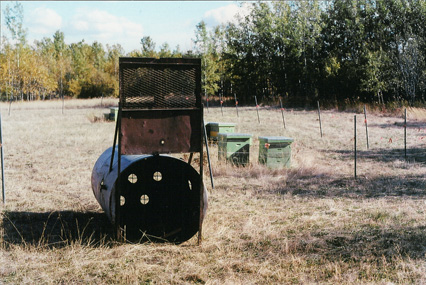
back
- Figure 2. A honey or brood comb partially hidden by a bear under leaves.
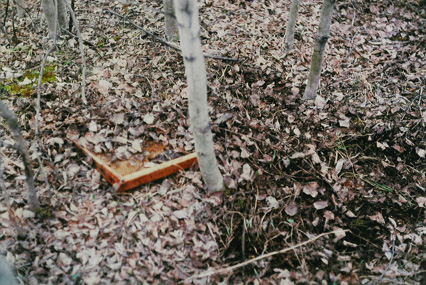
back
- Figure 3. A leg-hold trap set up between poplar branches.
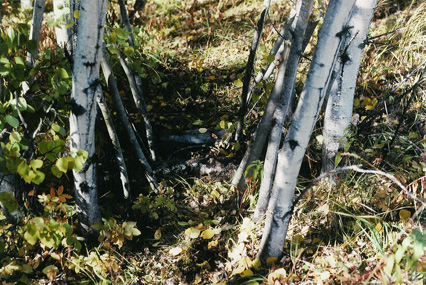
back
- Figure 4. The bear captured in a leg-hold trap.
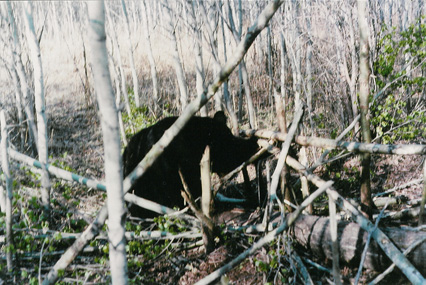
back
- Figure 5. The bear being carried to a clearing.
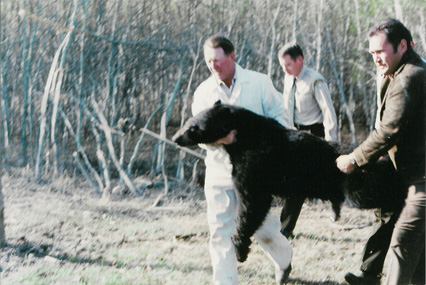
back
- Figure 6. The bear measured for statistical records.
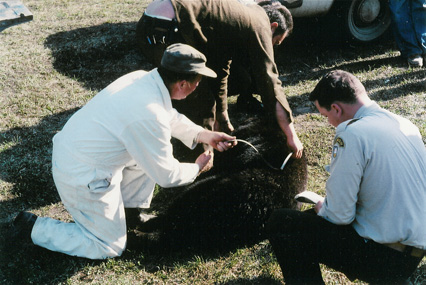
back
- Figure 7. The bear's ear tagged.
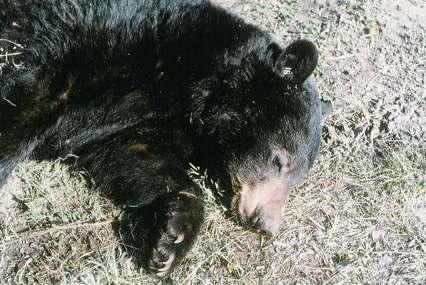
back
- Figure 8. A high platform fastened to large trees holding the nucleus and drone colonies.
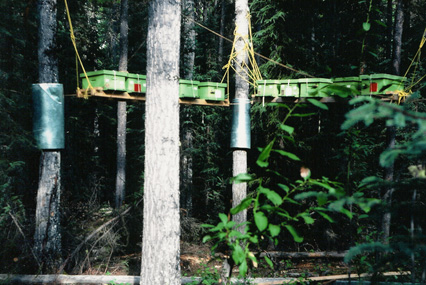
back
- Figure 9. The nucleus hives suspended from trees at a height of 5-6.5 m.
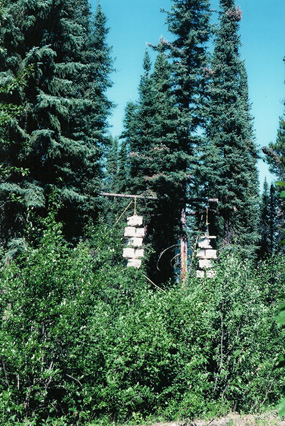
back
- Figure 10. Isolated mating yard with drone and nucleus colonies.
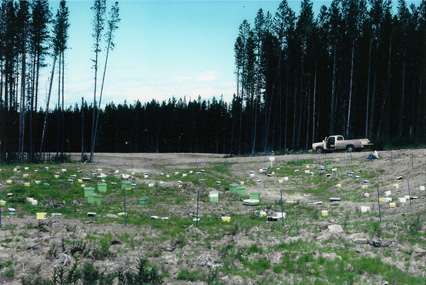
back
- Figure 11. Vegetation controlled under the electric fence.

back
- Figure 12. Bear footprints outside the fence.
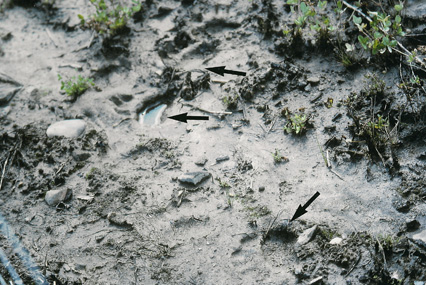
back
- Figure 13. A hive damaged and the colony destroyed by a bear.
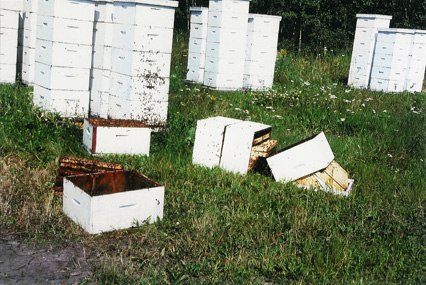
back
- Figure 14. Evidence of a bear digging under the electric fence.
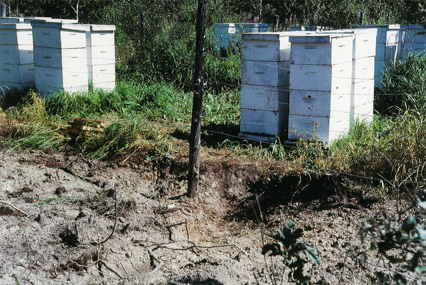
back
References
Lord, W. G. (1979) Black bear depredation of honey bees. American Bee Journal. 119(12): 818-821.
Szabo, T. I. (1986a) The modified Alberta nucleus hive. American Bee Journal. 126(8): 552-554.
Szabo, T. I. (1986b) Mating distance of the honeybee in north-western Alberta Canada. Journal of Apicultural Research. 25(4): 227-233.
Szabo, T. I.; Lefkovitch, L. P. (1987) Fourth generation of closed-population honeybee breeding. 1. Comparison of selected and control strains. Journal of Apicultural Research. 26(3): 170-180.
© 2005 T.I. Szabo and D.C. Szabo
Bonus Images

